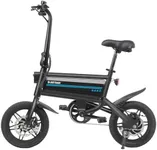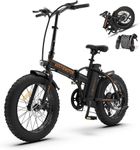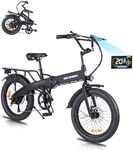Buying Guide for the Best Folding Electric Bikes
Choosing a folding electric bike is all about finding the right balance between portability, performance, and comfort. These bikes are designed to be compact and easy to carry or store, making them ideal for commuters, travelers, or anyone with limited storage space. When shopping for a folding electric bike, it's important to consider how you'll use it—whether for daily commuting, leisure rides, or mixed travel with public transport. Understanding the key features will help you pick a bike that fits your lifestyle and needs.Folding MechanismThe folding mechanism refers to how the bike folds and unfolds, which affects its ease of use and portability. Some bikes fold in the middle, while others have additional folding points on the handlebars or pedals. Simpler mechanisms are quicker and easier to operate, making them great for frequent folding, while more complex systems might offer a smaller folded size but take longer to set up. If you plan to fold and unfold your bike often, look for a straightforward mechanism. If storage space is your main concern, a more compact fold might be worth the extra effort.
WeightWeight is a crucial factor because it determines how easy the bike is to carry when folded. Lighter bikes are easier to lift onto public transport or up stairs, but they may have fewer features or a smaller battery. Heavier bikes can offer more comfort and power but might be challenging to carry for long distances. Think about how much carrying you'll actually do—if you need to lift the bike often, prioritize a lighter model. If you'll mostly roll it or store it without much lifting, a heavier bike could be fine.
Battery RangeBattery range tells you how far the bike can travel on a single charge, which is important for planning your rides. Ranges can vary widely, from around 15 miles to over 50 miles, depending on the battery size and how much you use the electric assist. Shorter ranges are suitable for quick commutes or errands, while longer ranges are better for extended rides or if you don't want to charge the bike every day. Consider your typical trip length and pick a range that covers your needs with some extra buffer.
Motor PowerMotor power, usually measured in watts, affects how much assistance the bike provides, especially on hills or when carrying extra weight. Lower-powered motors (around 250W) are fine for flat city riding and lighter riders, while higher-powered motors (350W and above) are better for hilly areas or heavier loads. If you expect to tackle steep inclines or want a faster ride, look for a more powerful motor. For mostly flat routes and moderate speeds, a lower-powered motor will be sufficient and may help conserve battery.
Wheel SizeWheel size impacts the bike's ride quality and portability. Smaller wheels (16-20 inches) make the bike more compact when folded and are easier to store, but they can feel less stable on rough roads. Larger wheels (20 inches and above) offer a smoother ride and better handling, especially over bumps, but make the folded bike bulkier. If you prioritize portability and short trips, smaller wheels are a good choice. For longer rides or rougher surfaces, larger wheels will provide more comfort.
Frame MaterialThe frame material affects the bike's weight, durability, and ride feel. Aluminum frames are lightweight and resistant to rust, making them popular for folding bikes. Steel frames are heavier but can absorb more road vibrations, offering a smoother ride. If you need to carry the bike often, an aluminum frame is usually best. If comfort and durability are more important, a steel frame might be worth considering.
AdjustabilityAdjustability refers to how much you can change the seat and handlebar height to fit your body. Good adjustability ensures a comfortable riding position, which is important for longer rides or if multiple people will use the bike. If you're taller or shorter than average, or if you plan to share the bike, look for models with a wide range of adjustments.
Integrated FeaturesIntegrated features like lights, racks, fenders, and displays can add convenience and safety to your rides. Built-in lights are great for visibility, racks help carry bags, and fenders keep you clean in wet conditions. If you plan to ride in all weather or carry items, look for these features. If you prefer a lighter, simpler bike, you might skip some extras and add accessories later as needed.












